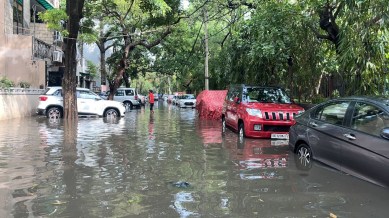Stay updated with the latest - Click here to follow us on Instagram
A tale of two Nizamuddins: How rain bridged divide between ‘posh’ East & ‘congested’ West
On usual days, as one enters Nizamuddin West, the aroma of various food items – from nihari and kababs to Halwa Paratha – fills the air. But on Friday, with the food stalls closed after the downpour, the fragrance was replaced by the foul stench of drain water which had taken over the streets.

Delhi’s Nizamuddin area, renowned for the dargah (shrine) of Sufi saint Nizamuddin Auliya, Humayun’s Tomb, and Sunder Nursery, presents a stark contrast between its eastern and western parts. While the east section is home to upscale residences, the west is a labyrinth of congested colonies with scant civic amenities. Friday’s torrential rain, though, bridged the differences as residents of both the areas dealt with knee-deep water submerging their surroundings.
On usual days, as one enters Nizamuddin West, the aroma of various food items – from nihari and kababs to Halwa Paratha – fills the air. But on Friday, with the food stalls closed after the downpour, the fragrance was replaced by the foul stench of drain water which had taken over the streets.
monthly limit of free stories.
with an Express account.
“When I woke up at 6 am, there was at least 4 to 5 feet of waterlogging around. The way the area was blocked, nobody could get out of their houses. We have just stepped out to take stock of our cars,” said Danish as he used a small pink bucket to remove water that had collected inside his car.
Shavez Abbasi, a resident of the dargah, was seen cleaning his furniture after his belongings were soiled by the floodwater. “The whole house was full of water. We didn’t realize it had started entering our rooms because we were asleep. There has been no electricity since 6 am, and all our electronics are now inundated,” he said.
“All the cars parked here were submerged after the rain last night,” said Rafiq Ahmad, a resident who works at the AIIMS kitchen, as he used a rag to clean his car. “There were 10 to 15 cars and many bikes, all submerged. The water also entered the mosque, so we couldn’t offer Jumma Namaz. The backflow from the Barapullah Nullah was overwhelming…we didn’t face these many issues 3 years ago,” he added.
Many shops operate here from small basements with no drainage points. Arsalan Jaffri, who owns a children’s school garment shop, said, “My shop has been inundated with dirty water since morning. I have tried to drain it out, but it keeps flowing back in. Most of the uniforms are white; it will be very difficult to clean them.”
Standing outside a library, Naseer Uddin shared his plight, “The library operates from a basement, which is now full of water. Nobody can go inside. The books must all be totally spoiled. The electricity transformer caught fire last night. I have never experienced such a dreadful night.”
On the other side of the Barapullah Nullah, adjacent to the railway station, lies Nizamuddin East. Here, the clustered colonies give way to sprawling multi-storey houses, and narrow, broken roads turn into wide pathways. But even here, the foul stench of nullah water was unavoidable after the rain. Cars lined the roads, inundated in water, with few wading through to run errands. Many others stood on their balconies, waiting for the water in the ground floors of their house to drain out.
“A lot of water entered our house. All the basements are still full of water. From G1 to G60, every house is inundated,” said Ramesh, who works for a resident named Atul Jha.
“Last year, my car got stuck in water, and it cost me Rs 1 lakh. I am facing the same problem today also. The Barapullah Nullah hasn’t been cleaned in years… When the Congress was in power, things were different,” said Raja Naim, standing on his balcony, waiting for the water to drain out.
Wading through the streets was Pinky who was concerned about the neighbourhood temple being damaged. Built in 1860, the Pracheen Hanuman Mandir had its premises filled with water, and a portion of the roof had collapsed. “This is an ancient temple. Due to the rainfall, the roof has collapsed. We have been trying to empty out the water from the premises since morning. Politicians visit mosques and temples when they want votes, but in the end, we are left to fend for ourselves,” said Shekher Rai, who works at the temple.